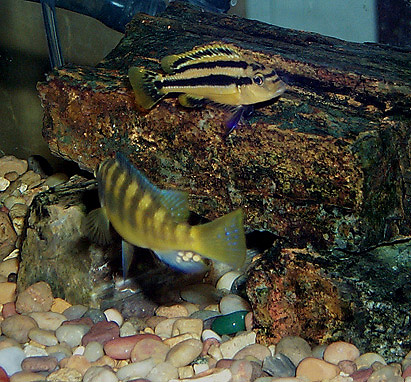
All rift lake cichlids are more aggressive than tropical community fish. However, some species are significantly more aggressive than others. When selecting species for a single tank, care should be made to not select fish which will kill each other when they mature.

The most aggressive species of cichlids of Lake Malawi tend to be from the genus Melanochromis (eg: M. chipokae and M. auratus) or the genus Maylandia (eg: M. crabro). These fish are extremely difficult to keep as adults without breeding them to replenish the population. The males will slowly but surely kill each other in territory battles.
Fortunately, there are numerous mid-aggressive species (eg: zebras, P. socolofi or M. johannii). The most mild-mannered species include Labidochromis caeruleus (Electric yellows) and Iodotropheus sprengerae (Rusty cichlids). These mild-mannered species should be kept in peaceful tanks with Tanganika cichlids or by themselves.
When selecting species, you should avoid keeping species of differing aggressiveness in a single tank. Also, aggression primarily occurs between fish of the same species. The more distantly related the fish, the less likely they will behave aggressively towards one another.
Your local pet store should be able to tell you how aggressive each species is. In the absence of such advice, you can purchase a good book or search the web for the species you want to buy. I highly recommend The Cichlid Fishes of Lake Malawi, Africa as an excellent species reference.
Many rift lake cichlids will only tolerate one male of each species in the tank. However, it is virtually impossible to sex juvenile rift lake cichlids so most people end up with two males. When the fight to the death inevitably begins, either sell the less-desirable male or try rearranging all the tank decorations. Sometimes upsetting territories will shuffle the social pecking order and reduce competition between the males.
When selecting your fish at the pet store, look for active fish which come to the front of the tank when you approach. Cichlids all have very good (if nearsighted) vision and can see well outside their tank. If the tank has no decorations, most of the fish should be in the lower half of the tank. Fish at the top of the tank which are not begging for food should be a cause for concern. Often this behavior is a response to poor water quality or temperature problems. Sluggish fish or fish with injuries should be avoided.
When stocking your aquarium, try to buy all the fish of a given species at the same time. Also try to buy the least aggressive species first so they have a chance to stake out a territory. Adding non-aggressive cichlids to a stocked tank is extremely difficult.
Whenever you add new fish to an existing stocked aquarium, always rearrange at least some of the tank decorations. I find that water changing the tank the same day I buy fish works best. I drain 25% of the water, rearrange the pots and rocks to form different shaped caves and then fill it back up and head out to the pet store. It takes about a day for all the territories to be settled so as long as the new fish arrives the same day, it will be on mostly equal footing with the other fish.
Comments? Questions? Contact l x s @ m a c . c o m.
All pages copyright ©2000-2015 Alexandra Ellwood.
Last modified at Sunday, April 19, 2015